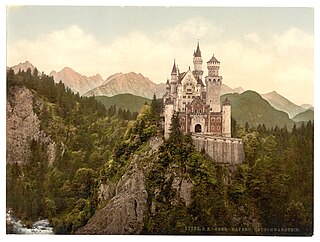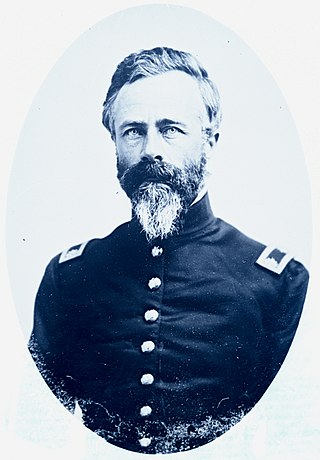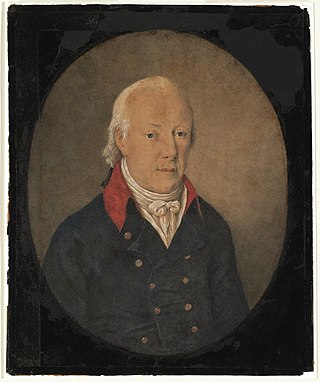Related Research Articles

The Mackinac Bridge is a suspension bridge that connects the Upper and Lower peninsulas of the U.S. state of Michigan. It spans the Straits of Mackinac, a body of water connecting Lake Michigan and Lake Huron, two of the Great Lakes. Opened in 1957, the 26,372-foot-long bridge is the world's 27th-longest main span and is the longest suspension bridge between anchorages in the Western Hemisphere. The Mackinac Bridge is part of Interstate 75 (I-75) and the Lake Michigan and Huron components of the Great Lakes Circle Tour across the straits; it is also a segment of the U.S. North Country National Scenic Trail. The bridge connects the city of St. Ignace to the north with the village of Mackinaw City to the south.

Mackinac County is a county in the Upper Peninsula of the U.S. state of Michigan. As of the 2020 Census, the population was 10,834. The county seat is St. Ignace. Formerly known as Michilimackinac County, in 1818 it was one of the first counties of the Michigan Territory, as it had long been a center of French and British colonial fur trading, a Catholic church and Protestant mission, and associated settlement.

The Autochrome Lumière was an early color photography process patented in 1903 by the Lumière brothers in France and first marketed in 1907. Autochrome was an additive color "mosaic screen plate" process. It was the principal color photography process in use before the advent of subtractive color film in the mid-1930s.

Fort Mackinac is a former British and American military outpost garrisoned from the late 18th century to the late 19th century in the city of Mackinac Island, Michigan, on Mackinac Island. The British built the fort during the American Revolutionary War to control the strategic Straits of Mackinac between Lake Michigan and Lake Huron, and by extension the fur trade on the Great Lakes. The British did not relinquish the fort until thirteen years after the end of the American Revolutionary War. Fort Mackinac later became the scene of two strategic battles for control of the Great Lakes during the War of 1812. During most of the 19th century, it served as an outpost of the United States Army. Closed in 1895, the fort has been adapted as a museum on the grounds of Mackinac Island State Park.


Photochrom, Fotochrom,Photochrome or the Aäc process is a process for producing colorized images from a single black-and-white photographic negative via the direct photographic transfer of the negative onto lithographic printing plates. The process is a photographic variant of chromolithography. Because no color information was preserved in the photographic process, the photographer would make detailed notes on the colors within the scene and use the notes to hand paint the negative before transferring the image through colored gels onto the printing plates.

William James Topley was a Canadian photographer based in Ottawa, Ontario. He was the best known of Ottawa’s nineteenth-century photographers and the most socially prominent one. Topley was noted for his portraiture of Canadian politicians and was a business partner of William Notman, having taken over Notman's Ottawa studio in 1872. A large number of photographs by Topley are now in the collection of Library and Archives Canada, including approximately 150,000 glass plates negatives and a set of 66 index albums covering the entire history of his Ottawa studios from 1868 until 1923.

Hand-colouring refers to any method of manually adding colour to a monochrome photograph, generally either to heighten the realism of the image or for artistic purposes. Hand-colouring is also known as hand painting or overpainting.

The Battle of Mackinac Island was a British victory in the War of 1812. Before the war, Fort Mackinac had been an important American trading post in the straits between Lake Michigan and Lake Huron. It was important for its influence and control over the Native American tribes in the area, which was sometimes referred to in historical documents as "Michilimackinac".
The series of Engagements on Lake Huron left the British in control of the lake and their Native American allies in control of the Old Northwest for the latter stages of the War of 1812.


Old Mackinac Point Light is a deactivated lighthouse located at the northern tip of the Lower Peninsula in the U.S. state of Michigan. The lighthouse is part of Fort Michilimackinac State Park in the village of Mackinaw City just east of the Mackinac Bridge.

Banquet photography is the photography of large groups of people, typically in a banquet setting such as a hotel or club banquet room, with the objective of commemorating an event. Clubs, associations, unions, circuses and debutante balls have all been captured by banquet photographers.

Thomas R. Williams was an antebellum United States Army officer and a brigadier general in the Union Army during the Civil War. He was killed as he commanded the Union troops at the Battle of Baton Rouge.

William Thomas Saunders (1832–1892) was a British-born photographer who settled in China and became the leading photographer in Shanghai during the late Qing dynasty. He was the first photographer known to produce hand-coloured photographs in China.

William Eastman Palmer & Sons was the name of a family partnership of photographers which was started in Devon in the 1860s by William Eastman Palmer and his wife Maria Louisa née Eales. By 1881 the five sons in the partnership were beginning to separate and to pursue their photographic careers further afield. As of 2011, the last recorded photograph by this family was made in 1935, in the Swindon area.

Mission Point is located on the southeast side of Mackinac Island, Michigan. It is approximately 21 acres (8.5 ha) in size between Robinson's Folly and the jetty terminating near Franks Street. The Island has a history of documented European development beginning with French Jesuit missionaries landing at the point in 1634, less than two decades after the Pilgrims landed at Plymouth Rock on the East Coast of North America.

Charles Henry Sawyer (1868-1954) was a painter and photographer in the United States.

Colonel Daniel Robertson was an officer in the British Army in North America, commandant of the British post at Michilimackinac, and a landowner in Chatham Township, Canada. Born in Scotland, he first joined the 42nd Regiment of Foot, also known as the "Black Watch," and was present at the British capture of Montreal in 1760, as well as the invasion of Martinique in 1762. During the American Revolutionary War, he was an officer in the 84th Regiment of Foot, another regiment of Scots known as the Royal Highland Emigrants. In 1779, he was appointed commandant of Fort Osgewatchie and oversaw Native American raids on American settlements on the Mohawk River.
References
- ↑ Coffin, C. 'Interview with family of H. Marshall Gardiner': "The H. was for Harry", Roggeveen D. (2018)
- ↑ Lisa Dziabis Calache, "William Henry Gardiner (1861-1935); An Early Canadian/American Photographer," Photographic Canadiana (September – October 1998): 8-13.
- ↑ Coffin, C. 'Interview with family of H. Marshall Gardiner'Roggeveen D. (2018)
- ↑ Steven C. Brisson, Picturesque Mackinac: The Photographs of William H. Gardiner, 1896-1915. Mackinac Island State Park Commission, 2005
Brisson, Steven C. Picturesque Mackinac: The Photographs of William H. Gardiner, 1896-1915 (2005)